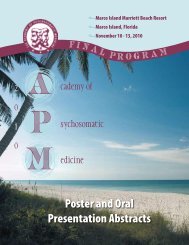Table of Contents - Academy of Psychosomatic Medicine
Table of Contents - Academy of Psychosomatic Medicine
Table of Contents - Academy of Psychosomatic Medicine
You also want an ePaper? Increase the reach of your titles
YUMPU automatically turns print PDFs into web optimized ePapers that Google loves.
months later, she was readmitted for recurrent confusion, insomnia,<br />
paranoia, and difficulty expressing herself. She was<br />
not in Addisonian crisis, CSF and MRI studies were normal,<br />
and paraneoplastic antibodies were negative. Her TSH was<br />
low, felt to be from overcorrected hypothyroidism. She was<br />
given pulse dose steroids for 3 days, with rapid taper down<br />
to physiologic doses when anti-thyroid antibodies were not<br />
elevated. As the steroids were tapered down, she developed<br />
catatonic signs including echopraxia, gegenhalten, ambitendency,<br />
and automatic obedience. Catatonic signs did not<br />
respond to high dose Ativan (up to 28 mg/day). The patient<br />
was transferred to inpatient psychiatry, received 11 treatments<br />
<strong>of</strong> ECT, and made a near complete recovery.<br />
Conclusion: This case illustrates the complex neuropsychiatric<br />
manifestations <strong>of</strong> autoimmune disease. We hypothesize<br />
our patient’s encephalopathy, and later catatonia, resulted<br />
from a combination <strong>of</strong> her autoimmune illnesses, and too<br />
rapid <strong>of</strong> a steroid taper. She responded well to electroconvulsive<br />
therapy, although more aggressive use <strong>of</strong> steroids<br />
may have been warranted as well.<br />
References:<br />
1) Anglin RE, Rosebush PI, Mazurek MF: The Neuropsychiatric<br />
Pr<strong>of</strong>ile <strong>of</strong> Addison’s Disease: Revisiting a Forgotten<br />
Phenomenon. J Neuropsychiatry Clin Neurosci 2006;<br />
18(4):450-459.<br />
2) Barnes MP et al.: The syndrome <strong>of</strong> Karl Ludwig Kahlbaum.<br />
Journal <strong>of</strong> Neurology, Neurosurgery, and Psychiatry<br />
1986; 49:991-996.<br />
3) Castillo et al.: SREAT. Arch Neurol 2006; 63:197-202.<br />
46. Catatonia Related to Ventriculomegaly<br />
in an Adolescent Mennonite Male - A Case<br />
Presentation, Literature Review, and Cultural<br />
Discussion<br />
Presenting Author: Matthew Lowe, DO<br />
Co-Authors: David Kasick, MD, Richard Gilchrist, MD, John<br />
Campo, MD<br />
Purpose: To discuss a case <strong>of</strong> catatonia in a Mennonite<br />
adolescent with ventriculomegaly, review relevant literature,<br />
and explore cultural implications.<br />
Methodology: Case description and literature review.<br />
Results: A 16-year-old Mennonite male was admitted to the<br />
neurosurgery service <strong>of</strong> an academic medical center with<br />
a four week history <strong>of</strong> confusion, disorientation, catatonia,<br />
disorganized thinking and behaviors, visual hallucinations,<br />
paranoid delusions, panic attacks, and intermittent suicidal<br />
ideation. There was no prior history <strong>of</strong> psychiatric disorder<br />
or treatment, and no history <strong>of</strong> alcohol, drug, or tobacco<br />
use. On examination, he displayed periodic staring, grimacing,<br />
echolalia, echopraxia, perseveration, and impulsivity.<br />
Laboratory evaluation was essentially normal. Brain MRI<br />
showed previously unrecognized right-sided ventriculomegaly.<br />
A right ventriculoperitoneal shunt was placed with resolution<br />
<strong>of</strong> ventriculomegaly on repeat MRI. Risperidone 0.5mg<br />
BID was initiated and increased to 1mg BID after transfer to<br />
19<br />
inpatient psychiatry, where improvements in disorganized<br />
thinking, speech, and behaviors were noted. Echopraxia<br />
persisted, but resolved completely after a single 2mg dose<br />
<strong>of</strong> lorazepam. Neurosurgery identified no abnormalities on<br />
two-week follow up and recommended no further workup<br />
or monitoring. The patient has slowly returned to his previous<br />
level <strong>of</strong> functioning. Follow up call at three weeks revealed<br />
no return <strong>of</strong> echopraxia after one dose <strong>of</strong> lorazepam<br />
and continued risperidone. Literature review revealed little<br />
regarding catatonia in association with ventriculomegaly or<br />
hydrocephalus. The family’s Mennonite culture likely influenced<br />
problem recognition and service use.<br />
Conclusion: This first reported case <strong>of</strong> echopraxia with<br />
ventriculomegaly as a possible cause gives further credence<br />
to searching for organic causes <strong>of</strong> psychiatric symptoms.<br />
47. Malnutrition due to Sustained Catatonia<br />
in an Ethiopian Male - A Case Presentation,<br />
Literature Review, and Cultural Discussion<br />
Presenting Author: Matthew Lowe, DO<br />
Co-Author: David Kasick, MD<br />
Purpose: To discuss a case <strong>of</strong> malnutrition due to catatonia<br />
in an Ethiopian male with review <strong>of</strong> the literature and discussion<br />
<strong>of</strong> the cultural implications <strong>of</strong> the case.<br />
Methodology: We present a 26-year-old Ethiopian male<br />
admitted to an academic medical center internal medicine<br />
service due to malnutrition. His BMI was 9. He was sleeping<br />
4 hours. He was receiving haloperidol and quetiapine<br />
for increasing agitation. Psychiatry evaluation noted staring<br />
with catatonic features: mutism, poor focus, negativism, social<br />
withdrawal, gegenhalten, and posturing. He did not talk<br />
or interact with hospital staff. Family reported he knew little<br />
English. He lived in Ethiopia until age <strong>of</strong> 19 and lived with<br />
his aunt in Sri Lanka for 7 years. He had moved to the U.S. 2<br />
months earlier to join his mother because family felt he may<br />
respond to her. Bloodwork showed malnutrition. Head CT<br />
showed cerebral atrophy. Continued anorexia necessitated<br />
an ICU transfer. One dose <strong>of</strong> Lorazepam 2mg was given for<br />
continued catatonic behaviors. He was then interactive with<br />
staff and surprisingly spoke English. He was able to feed<br />
himself. Nutritional status improved before discharge. Lorazepam<br />
was scheduled to continue outpatient.<br />
Results: A literature review revealed few reports <strong>of</strong> malnutrition<br />
caused by catatonia. The family’s Ethiopian culture<br />
and lack <strong>of</strong> fluency in English influenced treatment in this<br />
case. Due to lack <strong>of</strong> available psychiatry services in Sir Lanka,<br />
this patient did not receive early intervention.<br />
Conclusion: A followup medical contact revealed no catatonic<br />
symptoms and gradual improvement in nutritional status<br />
with continued lorazepa



